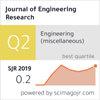蒸汽压缩制冷循环中纳米润滑剂的参数分析
IF 2.2
4区 工程技术
Q3 ENGINEERING, MULTIDISCIPLINARY
引用次数: 0
摘要
随着全球能源危机的升级和随之而来的能源消耗的激增,特别是由于建筑物中的空调系统,迫切需要可持续的解决方案来缓解这种不断增长的需求。蒸汽压缩制冷(VCR)循环在住宅、商业和工业领域无处不在,占全球电力消耗的很大一部分,超过10%。在气候炎热的地区,这一需求进一步加剧。因此,迫切需要解决这些系统对环境的影响,特别是在降低其全球变暖潜能值(GWP)方面。为了回应这一迫切需要,本研究旨在为VCR系统开发一个全面的数值模型,重点关注纳米润滑剂的实施。主要目的是评估将Al2O3纳米颗粒融入润滑油(称为纳米润滑剂)对VCR循环性能的影响。该研究的范围包括在制冷系统中的纳米润滑剂的调查,旨在提高其效率和环境的可持续性。利用工程方程求解器(EES),建立了使用R-410A制冷剂的VCR循环的数值模型。该模型特别强调压缩机组件,该组件被聚酯(POE)油基淹没。该研究探讨了各种参数,包括环境条件、制冷剂对油的溶解比和纳米颗粒的质量浓度,以评估它们对系统性能的影响。结果表明,在引入Al2O3纳米颗粒之前先注入基础油,性能显著提高,纳米颗粒整合后性能进一步提高。具体来说,与基本情况配置相比,VCR系统的性能系数(COP)显着增加。此外,采用环保制冷剂,如R-32,在纳米颗粒实施后,COP值有望提高4%。此外,研究表明,在使用纳米润滑剂时,如果油质量浓度较高,压缩机排气温度可降低20%,这表明VCR系统压缩机的耐用性和使用寿命得到了提高。这些发现强调了纳米润滑剂在制冷系统的效率和环境可持续性方面的潜力。总之,本研究的发现为纳米润滑剂在VCR循环中的应用提供了有价值的见解,强调了它们在提高系统性能和减轻环境影响方面的潜力。面对日益严峻的能源挑战,这些进步为开发更可持续的制冷技术带来了希望。本文章由计算机程序翻译,如有差异,请以英文原文为准。
Parametric analysis for nanolubricant in vapor compression refrigeration cycle
With the escalating global energy crisis and the consequential surge in energy consumption, particularly attributed to air conditioning (AC) systems in buildings, there arises a pressing need for sustainable solutions to mitigate this escalating demand. Vapor compression refrigeration (VCR) cycles, ubiquitous across residential, commercial, and industrial sectors, represent a significant portion of global electricity consumption, exceeding 10%. This demand is further exacerbated in regions characterized by hot climates. Consequently, there is a critical imperative to address the environmental impact of these systems, particularly in terms of reducing their Global Warming Potential (GWP). In response to this imperative, this study aims to develop a comprehensive numerical model for VCR systems, focusing on the implementation of nanolubricants. The primary objective is to assess the impact of integrating Al2O3 nanoparticles into the lubricating oil (referred to as nanolubricant) on the performance of the VCR cycle. The scope of the study encompasses the investigation of nanolubricants within refrigeration systems, aiming to enhance their efficiency and environmental sustainability. Utilizing the Engineering Equation Solver (EES), a numerical model of a VCR cycle utilizing R-410A refrigerant is developed. The model specifically emphasizes the compressor component, which is flooded with a polyolester (POE) oil base. The study explores various parameters, including ambient conditions, refrigerant-to-oil dissolving ratio, and mass concentration of nanoparticles, to evaluate their influence on system performance. The results indicate a significant enhancement in performance when flooding the base oil before introducing Al2O3 nanoparticles, with further improvements observed upon nanoparticle integration. Specifically, the coefficient of performance (COP) of the VCR system exhibits a notable increase compared to the base case configuration. Additionally, the adoption of eco-friendly refrigerants, such as R-32, demonstrates promising COP values following nanoparticle implementation by up to 4%. Moreover, the study reveals a reduction in compressor discharge temperature by up to 20% with higher oil mass concentrations during nanolubricant implementation, indicating enhanced durability and longevity of the VCR system’s compressor. These findings underscore the potential of nanolubricants to contribute to both the efficiency and environmental sustainability of refrigeration systems. In conclusion, the findings of this study offer valuable insights into the utilization of nanolubricants in VCR cycles, highlighting their potential to enhance system performance and mitigate environmental impact. These advancements hold promise for the development of more sustainable refrigeration technologies in the face of mounting energy challenges.
求助全文
通过发布文献求助,成功后即可免费获取论文全文。
去求助
来源期刊

Journal of Engineering Research
ENGINEERING, MULTIDISCIPLINARY-
CiteScore
1.60
自引率
10.00%
发文量
181
审稿时长
20 weeks
期刊介绍:
Journal of Engineering Research (JER) is a international, peer reviewed journal which publishes full length original research papers, reviews, case studies related to all areas of Engineering such as: Civil, Mechanical, Industrial, Electrical, Computer, Chemical, Petroleum, Aerospace, Architectural, Biomedical, Coastal, Environmental, Marine & Ocean, Metallurgical & Materials, software, Surveying, Systems and Manufacturing Engineering. In particular, JER focuses on innovative approaches and methods that contribute to solving the environmental and manufacturing problems, which exist primarily in the Arabian Gulf region and the Middle East countries. Kuwait University used to publish the Journal "Kuwait Journal of Science and Engineering" (ISSN: 1024-8684), which included Science and Engineering articles since 1974. In 2011 the decision was taken to split KJSE into two independent Journals - "Journal of Engineering Research "(JER) and "Kuwait Journal of Science" (KJS).
 求助内容:
求助内容: 应助结果提醒方式:
应助结果提醒方式:


